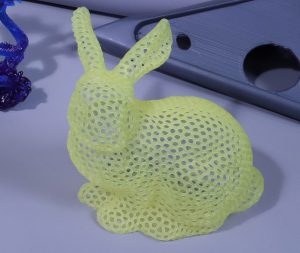How does Resin 3D printing work? This is a pretty common question for those who are new to the concept of 3D printing. It is difficult to comprehend how a liquid resin can not only become a solid three-dimensional shape but also have pinpoint accuracy and feature incredible detail. And furthermore, is possible with a 3D printer that costs only a few hundred dollars.
This technology is not new. It’s believed to have originally been developed by the Japanese in the 1970s and then later in 1984, a patent was filed by an American, Chuck Hall. Regardless of the exact method of production, almost all of the liquid-based technologies we’ve seen recently have been enabled by the expiration of Hull’s patent.
If you want an in-depth look at the history or more on the technical aspects, there are many articles if you search the subject on the internet. As for this guide, it’s important to understand that the patent for this technology expired in 2014… which opened the door for the low cost, desktop SLA/DLP/MSLA 3D Resin Printers to be manufactured and sold to the masses.
The company Formlabs, produced the first Desktop SLA 3D resin printer called the Form 1. However, In 2012 they were sued for patent infringement after the company launched their wildly successful Kickstarter campaign and went on to raise nearly $3 million for their desktop SLA 3D printer. In December of 2014, they settled and now pay an 8% royalty for every product sold.
Since they paved the way, there has been a large number of desktop Resin printers come onto the market. There are several less common types, so the focus here is on those that are considered the most popular, and the methods they use to 3D print objects with resin. That is, how in 2022 does 3D resin printing work!
How Does Resin 3D Printing Work Today?
- The SLA (Stereolithography) 3D printing technology, was the one to kick off the desktop revolution. create three-dimensional objects by “colouring in” each layer using an ultraviolet laser beam that is focused on a vat of liquid photopolymer resin. These printers use a series of gimbaled mirrors to angle the laser to focus on the area that needs to be cured.
- The DLP (Digital Light Processing) system also uses a UV light source to cure the resin, but instead of a laser, it uses a projector module to cure each layer of the object being printed. Rather than the SLA method, of “colouring in” with a fine laser, this technology is much faster as it exposes the entire layer at a time. Therefore, it would take the same time to print a build plate full of models as it would to print just one single model. For printing dental models, where speed and accuracy is important, this technology is preferred to the SLA method of printing.
- The more recent MSLA (Masked Stereolithography) 3D resin printer uses an LCD screen and an array of UV 405nm LED diodes. The LCD screen ‘cuts’ the shape of each layer, allowing the UV light to pass through and cure the photos-sensitive UV resin. The areas that are ‘masked’ do not allow the light to pass so the resin is not exposed and can remain uncured. This technology is low cost, as the printers use Monochrome LCD screens and cheap LED arrays to expose the photopolymer resin. Unlike DLP, which uses relatively expensive projector modules to do the same job. Unfortunately, the low-cost MSLA printers are quality restricted by the pixel concentration on the LCD screens. Larger sized printers need bigger screens which, mean bigger pixels and results in a lower definition of the model in the X/Y axis). The resolution can be increased by adding a 4K, 6K or even 8K screen to the 3D printer. This does improve the X/Y resolution and quality of the models it produces but also increases the upfront cost of the resin 3D printer. If the screen is damaged or needs replacing it will be more expensive to do so!
Formlabs is one of the well-known companies in 3D printing and were responsible for bringing SLA 3D printing to the desktop at an accessible price point. However, this new free market hasn’t been without its bumps in the road. In 2012 they were sued for patent infringement after the company launched their wildly successful Kickstarter campaign and went on to raise nearly $3 million for their desktop SLA 3D printer. In December of 2014, they settled and now pay an 8% royalty for every product sold.
Since they paved the way, there has been a large number of desktop Resin printers come on to the market.
I hope this helps answer the question, How Does Resin 3D Printing Work and increase your appreciation of the incredible technology behind this mode of printing! If you’re convinced and want to invest in one yourself, click HERE to read about what you should look for when buying a 3D printer.
